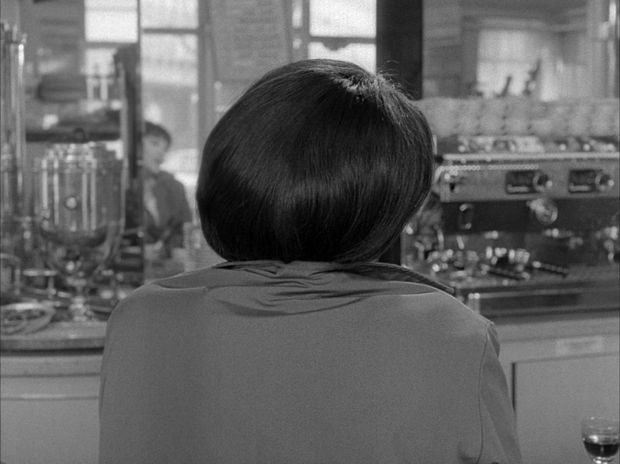
After the extreme, iconic close-ups of Anna Karina in the credit sequence of Vivre Sa Vie, Godard launches into the first of the film's twelve tableaux, or chapters, by conspicuously hiding her face from us. He shoots her from behind as she sits at a café bar facing a mirror behind the bar, in which we can barely make out her reflection.
She is having a conversation with a man who's also sitting at the bar, out of frame. When Godard finally cuts to the man, isolated in his own frame, he is also seen from behind, but his face is not visible in the mirror.
Karina's character is breaking up with the man — Godard's visual strategy echoes their estrangement, of course, but hiding Karina's face also directs us to what she's saying, to the character's story, and away from the iconic status of his alluring star.
The woman asks the man if he wants to play a game of pinball — the camera is on his back when she proposes this and her hand comes into the frame to rest on his shoulder. Having shared the same frame at last, they move to the pinball machine, in a shot where they are both visible, their faces revealed to us partially in an angle that's still from behind but more to the side.
Though sharing the same frame, their concentration is not on each other but on the pinball machine, and our attention is divided between them and a view of Paris outside the window behind them. The man describes an essay by a child about animals, in which the child writes that birds are made up of an outside and an inside. The child says that when you take away the outside, the inside is left, and when you take away the inside the soul is left. As the man describes this essay, the camera pans left to isolate Karina in the frame.
The essay echoes the dynamic of Godard's film — in which he pits Karina's outside, her beauty and her cinematic allure, against her character's story, her character's inner struggle, and suggests that, or wonders if, when her story and struggle are concluded, there will be some kind of revelation of a soul, one which will perhaps reconcile the actor and the character — that is, a soul which both share.
This is less a statement of Godard's purpose than a question he is asking us to think about as we watch the film — and in some sense a question he is asking of cinema itself.
Previously:
VIVRE SA VIE — CREDIT SEQUENCE
Next:
